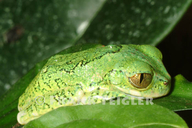|
Description
A large to very large (male 39-50 mm, female 61-85 mm) Leptopelis from the Eastern Arc Mountains and Rungwe, Tanzania with well developed webbing and a large tympanum. Males with pectoral glands. Phase A vivid green with fine black vermiculations, sides marbled in black and white. Phase B brown with an irregular darker triangle on dorsum with apex pointing forward, a dark bar or spot between the eyes, and sides heavily marbeled.
All juveniles have the beautifil phase A and so do some of the males, while all the females collected by Schiøtz belong to phase B. Some specimens show a transition between the phases where the dorsum has an iridescent green coloration almost covering the phase B pattern. An adult male phase A kept in a terrarium changed within eight months to phase B. Specimens in phase B are very similar to L. flavomaculatus (Schiotz 1999).
Distribution and Habitat
Country distribution from AmphibiaWeb's database: Tanzania, United Republic of
A forest species, often found sitting quietly on branches above water. It is known from the eastern Usumbaras and from Rungwe Mts., but strangely enough not with certainty from Uluguru and Udzungwas (Schiotz 1999).
Life History, Abundance, Activity, and Special Behaviors
Voice- The voice is a single clack with a peculiar tonal quality resulting from a large number of harmonics about 250-300 cps. apart with a vibrato (Schiotz 1999).
References
Schiøtz, A. (1999). Treefrogs of Africa. Edition Chimaira, Frankfurt am Main.
Originally submitted by: Arie van der Meijden (first posted 2000-10-09)
Edited by: Kellie Whittaker (2008-09-10)Species Account Citation: AmphibiaWeb 2008 Leptopelis vermiculatus <https://amphibiaweb.org/species/3677> University of California, Berkeley, CA, USA. Accessed Jun 13, 2025.
Feedback or comments about this page.
Citation: AmphibiaWeb. 2025. <https://amphibiaweb.org> University of California, Berkeley, CA, USA. Accessed 13 Jun 2025.
AmphibiaWeb's policy on data use.
|




 Map of Life
Map of Life